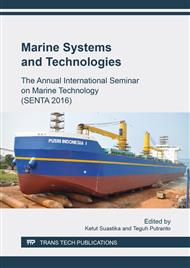[1]
Sevan Marine, Western Isles Development Project (WIDP) FPSO-FEED Study-Mooring Analysis Report, Report No. 54850-SMA-J-RA-0010, (2011).
Google Scholar
[2]
K. Syvertsen, The SSP: A New Class of Hull for the Oil Industry, Trondheim, (2011).
Google Scholar
[3]
E.B. Djatmiko, The Behavior and Operability of Ocean Structure in Waves, ITS Press, Surabaya, 2012 (in Indonesian).
Google Scholar
[4]
R.N. Perwitasari, Hydrodynamics Interaction and Mooring Analysis for Offloading between FPSO and LNG Shuttle Tanker, Master Thesis, Department of Marine Technology, NTNU, Trondheim, Norway, (2010).
Google Scholar
[5]
R. Afriana, Coupled Dynamic Analysis of Cylindrical FPSO, Moorings, and Riser Based on Numerical Simulation, Master Thesis, Department of Offshore Technology, University of Stavanger, Norway, (2011).
Google Scholar
[6]
ABS, Rules for Building and Classing of MODU, American Bureau of Shipping, Houston, Texas, USA, (2012).
Google Scholar
[7]
E.B. Djatmiko, M. Murtedjo, Enhancing the operational performance of SWATH-FPSR, In: Proc. Naval Platform Technology Seminar 2005, NPTS 2005, the Republic of Singapore Navy (RSN), Singapore, May (2005).
Google Scholar
[8]
X.B. Chen, Offshore hydrodynamics and applications, In: Proc. The IES Journal Part A: Civil & Structural Engineering, Vol. 4, No. 3 (August 2011) 124–142.
Google Scholar
[9]
F. van Walree and H.J.J. van den Boom, Wind, wave, and current loads on semisubmersibles, In: Proc. 23rd Annual Offshore Technology Conference, Paper No. OTC-6521, Houston, Texas, USA, May 6-9, (1991).
DOI: 10.4043/6521-ms
Google Scholar
[10]
O.M. Faltinsen, Sea Loads on Ships and Offshore Structures, University of Cambridge, (1990).
Google Scholar
[11]
API, Design and Analysis of Stationkeeping Systems for Floating Structures, API RP 2SK, 3rd edition, American Petroleum Institute, Washington D.C., USA, (2005).
Google Scholar
[12]
BV, HydroSTAR v7. 25 for Experts User Manual, Bureau Veritas, Paris, (2015).
Google Scholar
[13]
G. Jagite and L. Domnisoru, Advanced seakeeping computation for an FSU ship under given environmental conditions, Buletinul AGIR, www. agir. ro/buletine/2602. pdf, retrieved Nov. 13, (2016).
Google Scholar
[14]
M.Y. Low and R.S. Langley, Time and frequency domain coupled analysis of deepwater floating production systems, Applied Ocean Research, 28(6) (2006) 371-385.
DOI: 10.1016/j.apor.2007.05.002
Google Scholar
[15]
F.T. Ogilvie, Recent progress toward the understanding and prediction of ship motions, In: Proc. 5th Sympo. on Naval Hydrodynamics, Office of Naval Research, Department of the Navy, USA, (1964).
Google Scholar
[16]
T.P. Ha, Frequency and Time Domain Motion and Mooring Analyses for a FPSO Operating in Deep Water, PhD Thesis, School of Marine Science and Technology, Newcastle University, UK, (2011).
Google Scholar
[17]
M.M. Larsen, Time-Domain Simulation of Floating Dynamic Marine Structures using USFOS, Master Thesis, Department of Marine Technology, NTNU, Trondheim, Norway, (2013).
Google Scholar
[18]
BV, Ariane7 User Manual, Bureau Veritas, Paris, (2014).
Google Scholar
[19]
DNV, Position Mooring, DNV OS E301, Det Norske Veritas, Norway, (2004).
DOI: 10.3940/rina.mre.2010.01
Google Scholar


